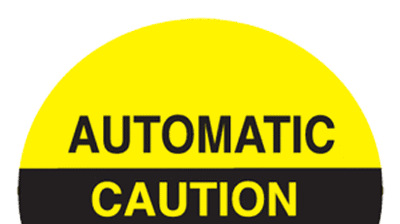REVOLVING DOOR INJURIES
Download PDF of this article here
By Michael Panish
Automatic Door Expert Witness
Within the past few months, I have been retained as expert witness to evaluate revolving door injuries in over a dozen different locations nationwide. While I usually see an even distribution of sliding door, swinging door, and revolving door injury cases, the revolving door injuries currently seem to be the most prevalent. What is particularly interesting is that no two of my recent cases were created by the same problem. A few were similar in sensor malfunctions, some were the result of metal fatigue of different types, and two cases were created by multiple user interactions.
No Daily Inspections or Safety Evaluations:
In each of my recent cases, one common factor was apparent. No daily inspections or safety evaluations were made by the management of the facilities where the revolving doors were installed. And, while critically important, the daily safety checks would not have prevented the resulting injuries in the multiple user incidents.
Two Recent Revolving Door Injury Case Consultations:
Attorneys contacted me to consult with them on the potential claims that they were considering.
In one case, a store patron was entering the revolving door from the interior of the store to exit the building. From video surveillance provided, an elderly patron decided to try and enter the revolving door from the exterior side of the store just as the door panel was approaching the fixed side panel of the drum. The patron in the process of leaving the store was completely absorbed in a conversation with her friend sharing the same segmented compartment of this four panel system. Both ladies were not paying any attention to their proximity with the door wing immediately in front of them. They appeared to be less than two inches from the face of the door as they were exiting the store. When the elderly gentleman entered the zone protected by the crush protection sensor, the sensor performed flawlessly and stopped the rotation of the doorway to prevent him from being trapped between the fixed panel and the approaching door wing. One of the two ladies continued walking forward into the winged panel in front of her, breaking her nose.
Another injury was created when a similar situation occurred. A woman was leaving a store, entered the revolving door while talking on her cell phone. A mother, pushing her small daughter in a stroller attempted to enter the revolving doorway, and the doorway abruptly stopped due to their proximity with the revolving door panel and the fixed panel. The woman with the cell phone smashed her face and phone into the door panel in front of her, breaking both the glass panel of the revolving door wing and two of her front teeth.
Revolving Doors:
It has always been my observation from the automatic door injury cases I have been involved in, that revolving doors can be the most dangerous type of automatic door systems found. But, that does not mean that they are not a useful product. Most manufacturers do everything possible to design products that possess multiple and redundant safety devices and sensors. The revolving doorway systems are typically the most complex products of any automatic door line. When these devices are all working in harmony with properly adjusted components and sensory inputs, there is still one aspect of these doorways that cannot be controlled. That variable is the erratic unpredictable and often impatient behavior of the average door user.
Compare Revolving Doors to a Ferris Wheel:
Picture a ferris wheel in an amusement park; that wheel is a vertical version of a horizontally installed revolving doorway. When a single rider is seated on the ferris wheel the revolving action of that wheel can be started. This action is similar to a single user of a revolving door beginning to enter the revolving doorway. If a rider is alone on the ferris wheel he can continually circle the ride without any interference until another rider wishes to get on the wheel. Likewise, a single user of a properly adjusted automatic revolving door is free to walk at an appropriate pace, slow down or even stop without affecting any other user of the doorway. When a second person wishes to get on the ferris wheel, the first rider is subjected to having the wheel stop while that second rider enters a gondola of the ferris wheel. So, even though the first rider may not know that another guest wants to ride the wheel, the first rider is subject to waiting, or being stopped abruptly while the second rider is loaded onto another car of the ferris wheel. The rotation, positioning of patrons, and interconnected usage make using a revolving automatic door very similar to riding a ferris wheel. The main difference is that in the case of a ferris wheel, a human attendant is usually responsible for governing the operation of the wheel, while in a revolving automatic door; the movement is controlled by a diverse network of sensors communicating with a robotic motor control device.
A single user of a properly functioning automatic revolving door is not subjected to any restrictions until a second or third user may create some sort of revolving obstruction conflict. When this happens everything from a slowing down of the revolution of the doorway to a complete stalling can and does occur. The first user of the doorway is now subjected to the behavior and potential improper usage of the revolving doorway by each consecutive successive user of these shared doorways.
I am not faulting the manufacturers of revolving doorways. In order to be in compliance with current standards, all modern revolving doors include multiple sensory systems. These devices include motion and pressure sensors of various designs and types providing the informational input to the motor controller. This machine sensory input is equivalent to human senses providing information to our brains. The main differences are the limitations of processing abilities and lack of independent thought in the door motor controller.
All manufacturers of automated door products strive to make their devices as safe as possible. One of the most basic problems where these door systems are installed is that the building management or owners do not understand how potentially serious an injury from these automated revolving door systems can be. Door manufacturers typically participate in industry programs where standards for performance and safe operation are determined and specified. Unfortunately, there seems to be a complete disconnection between many original design ideals from the manufacturer and the installation and maintenance programs followed by various service providers and end users.
By the time an injury has happened, it is common to observe sensors that have been seriously damaged, disconnected, or out of alignment. Maintenance providers, whether in-house or from a door service company, often make bad decisions and do not follow all of the recommendations and requirements suggested by the revolving door manufacturers. When improper service and maintenance has taken place, in essence, the revolving door has been blinded from the sensory input that was designed to protect the users of these door systems from harm.
The decision to use a revolving doorway over another type of automated device is promoted for a variety of reasons. Air locks, traffic patterns, and architects and designers promoting an upscale product and a specific design look are just a few reasons for making the revolving door choice. But the reality of the daily operation, maintenance, and potential patron usage and abuse make the revolving doors less appealing in the real world than other automatic door choices. It is critically important to understand the customer demographics and customer base abilities when deciding to install any kind of automatic door system. In many businesses that attract elderly, handicapped or disabled people, they often use motorized scooters or wheel chairs as their primary mode of transportation. Older people are often walking with a cane or walker, and these devices limit their mobility. Walking or riding in a circular path of a revolving doorway leads to additional problems that make entering a building significantly more difficult than walking through a sliding, parting, or swinging door system. Damage to the revolving door panels is more prevalent when motorized carts and wheel chairs are commonly used by the customer base, as the panels are constantly hit by poorly controlled conveyances.
From my experience as an automatic door injury expert witness, I am often informed by management or owners that the revolving door system never performed properly, since its original installation. Yet, they continued the operation of the door aware of its fault. Some hotel and store managers have claimed that when the original installation of the revolving door took place, it had remained outside in the rain prior to being placed in the building. Others claim that when the original installation was done it was not handled by experienced door installers. Sometimes union requirements have dictated that local union members install the door systems. Although there may have been involvement on the part of the territorialized product vendor who provided the door, there was little or no direct supervision of the installations done by those required installers. This becomes problematic for the territorialized factory door vendors, as they should have documented the non-factory trained installation, storage situation, and all other factors that could lead to future failures of the door components as a result of questionable installation practices. Installations done by factory trained technicians are generally better than when performed by inexperienced outside door installers with little or no automatic door training. As discussed in many of my other automatic door articles, thorough and complete documentation of all site conditions, installation issues and service policies are essential to identify deficiencies in these door systems on an ongoing basis.
Summary:
Automatic revolving doors have their share in the marketplace and will probably continue to be installed as architects, designers and manufacturers promote their virtues.
Manufacturers have been responsive and active developing and promoting safety devices for these products. The thorough and appropriate daily safety inspections are the responsibility and non delegable duty of the management or owners of any property where automatic door products of any kind are installed. While annual inspections are encouraged and promoted by industry organizations, a routine daily inspection is the only true test of the operating characteristics of the doorway.
The general public does not understand that a certain heightened level of awareness is appropriate and required of them when using any automatic door system. The benefits of automated door systems generally outweigh the potential dangers that an occasional improperly functioning door system can create. Today's culture of constantly using phones and wireless communication devices has created a dangerous shift of attention from being aware of your surroundings to being distracted and oblivious of your immediate environmental location. For many of the same reasons of distraction where states have outlawed the usage of cell phones and text messaging while driving, the public needs to be aware that there is a personal responsibility and required increase of awareness for your own well-being. It is common sense that when you are distracted, your perception, understanding and reaction to immediate dangerous situations are impaired.
Proper evaluation of the demographics of patrons that use your facility can and should direct the appropriate choices for selection of door system installations.
Mike Panish is a forensic expert witness and consultant in the construction industry. One of his areas of expertise pertains to automatic door cases and he has over 35 years of hands on experience dealing with commercial, multi residential, hotel, hospital, lab and other locations where specialty door systems are needed. He has written several articles on the subject of door related claims and maintenance issues related to automatic door systems. He is licensed as a door and hardware contractor in the State of California. He has been involved in automatic door cases across the United States. He has been used as a consultant and has been retained and designated as expert in many types of door injury related claims for both the plaintiff and defense. Mike is able to quickly ascertain the facts, explain the critical information pertaining to your case and can assist you in developing your case from discovery through trial. He has offices in California, New Hampshire and Massachusetts. He is available for nationwide consulting and expert analysis and testimony. Michael Panish can be reached at (888) 902-4272 (Sharon).
Copyright - Michael Panish, Constructionwitness.com 2/2/2013
Other Automatic Door Articles by Michael Panish
The Ins and Outs of Automatic Door Operation
AUTOMATIC DOORS - The Importance of Checking Your Doors Daily
Automatic Door Service Providers - How to Limit your Liability
A Brief Tutorial on Garage Door Safety & Installation



